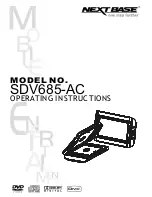
22
A new marker frequency can be programmed directly from the keyboard or by using the rotary
control and cursor keys. The marker can be programmed to be any frequency within the sweep
range but the actual frequency will be that of the nearest ‘minor’ step, see Principles of Operation
section for an explanation of major and minor frequency steps.
The minimum marker duration is 100us (1 minor step) but for longer sweeps the marker duration
is increased (in 100us increments) such that is never less than 1/250th of the complete sweep in
order to keep the marker visible if the whole sweep is displayed on an oscilloscope. Thus for a
sweep time of 100ms the marker duration would be 400us. The first 100us increment represents
the closest frequency step to the programmed marker value.
The marker will not show if it is programmed to a frequency outside of the sweep range.
Frequency Stepping Resolution
The generator frequency is stepped, not truly linearly swept, between the Start and Stop
frequencies. The number of discrete frequency steps in a sweep is determined by the sweep
time set on the
SWEEP TIME
screen; the size of each step, i.e. the frequency stepping
resolution, is determined by the number of steps and the sweep range (set on the
SWEEP
RANGE
screen).
At the shortest sweep times ( i.e. the fewest steps) with the widest frequency spans the
frequency changes will be quite large at each step; if the output is applied to a filter, for example,
the response will be a succession of step-change levels with (at higher frequencies) many cycles
of the same frequency at each step. This is a limitation of a DDS generator in sweep mode but in
part, of course, this effect can only be created because of the very wide sweeps that can be
achieved with DDS techniques; analogue generators usually have more restricted capabilities.
















































